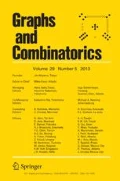Abstract
In this paper, we introduce the notion of path-bicolorability that generalizes bipartite graphs in a natural way: For k ≥ 2, a graph G = (V, E) is P k -bicolorable if its vertex set V can be partitioned into two subsets (i.e., color classes) V 1 and V 2 such that for every induced P k (a path with exactly k − 1 edges and k vertices) in G, the two colors alternate along the P k , i.e., no two consecutive vertices of the P k belong to the same color class V i , i = 1, 2. Obviously, a graph is bipartite if and only if it is P 2-bicolorable. We give a structural characterization of P 3-bicolorable graphs which also implies linear time recognition of these graphs. Moreover, we give a characterization of P 4-bicolorable graphs in terms of forbidden subgraphs.
Similar content being viewed by others
References
Albertson M.O., Jamison R.E., Hedetniemi S.T., Locke S.C.: The subchromatic number of a graph. Discrete Math. 74, 33–49 (1989)
Benzaken C., Hammer P.L., de Werra D.: Split graphs of Dilworth number 2. Discrete Math. 55, 123–128 (1985)
Berry A., Golumbic M.C., Lipshteyn M.: Recognizing chordal probe graphs and cycle-bicolorable graphs. SIAM J. Discrete Math. 21, 573–591 (2007)
Brandstädt A., Le V.B.: Split-perfect graphs: characterizations and algorithmic use. SIAM J. Discrete Math. 17, 341–360 (2004)
Brandstädt A., Le V.B.: Structure and linear time recognition of 3-leaf powers. Inf. Process. Lett. 98, 133–138 (2006)
Brandstädt, A., Le, V.B., Spinrad, J.P.: Graph classes: a survey. In: SIAM Monographs on Discrete Math. Appl., vol. 3. SIAM, Philadelphia (1999)
Broersma H., Fomin F.V., Nešetřil J., Woeginger G.: More about subcolorings. Computing 69, 187–203 (2002)
Chudnovsky M., Robertson N., Seymour P., Thomas R.: The strong perfect graph theorem. Ann. Math. 64, 51–229 (2006)
Corneil D.G., Lerchs H., Stewart-Burlingham L.: Complement reducible graphs. Discrete Appl. Math. 3, 163–174 (1981)
Corneil D.G., Perl Y., Stewart L.K.: A linear recognition algorithm for cographs. SIAM J. Comput. 14, 926–934 (1985)
Fiala J., Jansen K., Le V.B., Seidel E.: Graph subcolorings: complexity and algorithms. SIAM J. Discrete Math. 16, 635–650 (2003)
Földes S., Hammer P.L.: Split graphs. Congressus Numerantium 19, 311–315 (1977)
Golumbic M.C., Lipshteyn M.: Chordal probe graphs. Discrete Appl. Math. 143, 221–237 (2004)
Hoàng, C.T.: Perfect graphs. Ph.D. thesis, School of Computer Science, McGill University Montreal (1985)
Hoàng C.T.: Alternating orientation and alternating colouration of perfect graphs. J. Combin. Theory (B) 42, 264–273 (1987)
Hoàng C.T., Le V.B.: P 4-free colorings and P 4-bipartite graphs. Discrete Math. Theor. Comput. Sci. 4, 109–122 (2001)
Hoàng C.T., Reed B.A.: Some classes of perfectly orderable graphs. J. Graph Theory 13, 445–463 (1989)
Jamison B., Olariu S.: P 4-reducible graphs—a class of uniquely tree representable graphs. Stud. Appl. Math. 81, 79–87 (1989)
Jamison B., Olariu S.: A linear-time recognition algorithm for P 4-reducible graphs. Theor. Comput. Sci. 145, 329–344 (1995)
Jamison B., Olariu S.: Recognizing P 4-sparse graphs in linear time. SIAM J. Comput. 21, 381–406 (1992)
Jamison B., Olariu S.: p-Components and the homogeneous decomposition of graphs. SIAM J. Discrete Math. 8, 448–463 (1995)
Lipshteyn, M.: Structured families of graphs: properties, algorithms, and representations. Ph.D. thesis, University of Haifa (2005)
McConnell R.M., Spinrad J.P.: Modular decomposition and transitive orientation. Discrete Math. 201, 189–241 (1999)
Nishimura N., Ragde P., Thilikos D.M.: On graph powers for leaf-labeled trees. J. Algorithms 42, 69–108 (2002)
Preissmann M., de Werra D., Mahadev N.V.R.: A note on superbrittle graphs. Discrete Math. 61, 259–267 (1986)
Author information
Authors and Affiliations
Corresponding author
Rights and permissions
About this article
Cite this article
Brandstädt, A., Golumbic, M.C., Le, V.B. et al. Path-Bicolorable Graphs. Graphs and Combinatorics 27, 799–819 (2011). https://doi.org/10.1007/s00373-010-1007-9
Received:
Revised:
Published:
Issue Date:
DOI: https://doi.org/10.1007/s00373-010-1007-9




